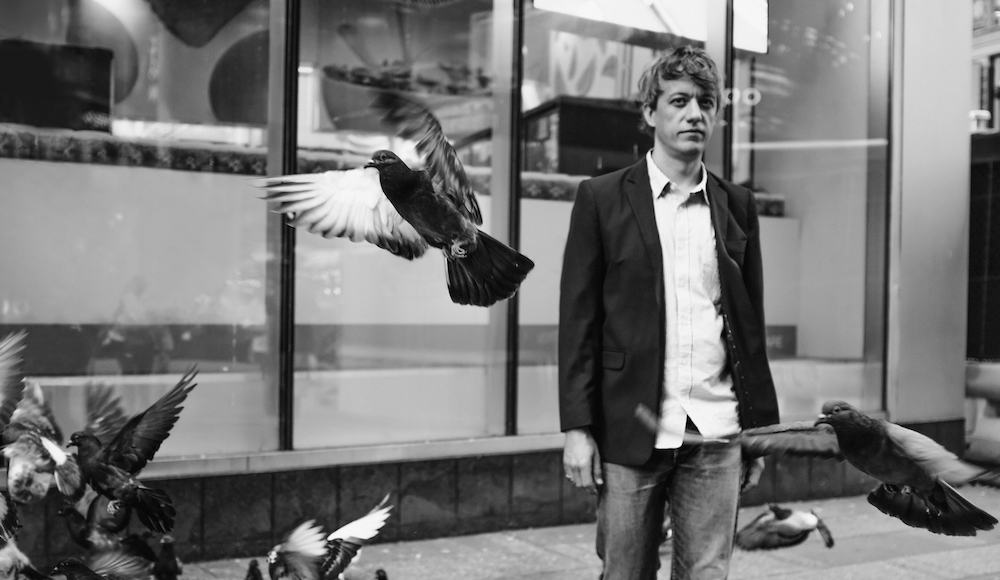Spotlight: Steve Gunn

“It was almost like a real session,” the soft-spoken guitarist and songwriter Steve Gunn jokes about his new album, The Unseen In Between. Drinking kombucha at a local coffee shop in Bed-Stuy, Brooklyn, it’s not the only time that Gunn remarks on the unusual normality of his career’s current moment, from the writing of the music to the recording of it.
With its nine tracks making equal home for Gunn’s atmospheric, soulful guitar playing and his equally atmospheric songs, The Unseen In Between is an arrival for the 41-year-old musician. Gunn’s fourth album since making the turn from instrumental and improvisational guitarist to more traditional songwriter, it moves easily from the Pink Floydian melancholy of “Morning is Mended” to the late-night solemnity of “Stonehurst Cowboy.”
“It’s almost like a reverse trajectory,” he observes. “Like, usually, it’s a guy playing simple songs and then 15 years later, playing feedback in front of an amp because he can’t take it anymore.” Though he doesn’t mean to, Gunn invokes a highly simplified arc of John Fahey, who pioneered American primitive style blues-folk picking in the ‘60s before turning to wild noise by the end of his career. Now, venerated as a godparent to the generation of players who Gunn is often lumped in with, Gunn’s path has been the opposite of Fahey’s, getting both simpler and heavier.
Touring as a bassist in a hardcore band when he was 15, the Philadelphia native found his path into music through “grindcore bands [that] scared the shit out of me.” His listening habits shifted from “Sonic Youth, Fugazi, bonehead hardcore stuff,” to “jazz and more really far out stuff.” As he found his way into the music scene and fell in love with “damaged” sounds, Gunn says his playing “got weird” and he discovered that “it was OK to smoke some grass and play some fucked up guitar stuff with your buddy.”
Improvising dreamscapes with GHQ, Gunn began to produce his own solo recordings. “I was dabbling in [songwriting] when I was doing GHQ,” Gunn says, as if it were an illicit activity. But, in the underground music scene that Gunn emerged from, it wasn’t always the easiest thing to just open one’s mouth and sing. He moved in parallel between raga-touched collages (like the 19-minute “Suntwice” on 2009’s Too Early for the Hammer) and solo acoustic instrumentals (as on Boerum Palace, also from 2009), as if circling his own musical center.
And after Gunn’s playing got weird, it got normal. He still dives into noisier improv in a duo with drummer John Truscinski but, lately, in terms of songwriting, he’s making a real effort toward simplicity, at least in approach. “Usually, I would figure out guitar stuff and have all these words written and put the pages on a table, then pick stuff out and slap it on top of guitar pieces,” he says. “But this time, I tried to write and sing the song, and play it as I wrote it. I’d never done that before, which sounds weird. I didn’t want to overthink it, or overthink the playing. My brain always wants to play something complicated; [it’s] where I come from as a player, like I have to come up with these grandiose things.”
While Gunn’s curlicues dot the The Unseen In Between, the mission was simplicity, aided by majordomo James Elkington, and—almost through sheer fate—bassist Tony Garnier, the longest ever tenured musician in Bob Dylan’s touring band. Playing an upright once owned by Charles Mingus, Garnier’s low end adds a gravitas to Gunn’s work, holding the songs together as emotionally coherent takes.
“The way he supports the songs is something I never experienced,” Gunn says. “‘Write out all the lyrics for me; I wanna hear what you’re singing about,’” he recalls Garnier telling him after their first take.
“I was expecting him to, like, plop the bassline on,” says the amazed guitarist. “But he was just so in tune, it was cool. It’s heavy, but it’s subtle.”
“Most of Steve’s songs that I played on would have some weird twist in the chord structure or melody or odd meter that was unexpected; some really challenging music as a player,” says Garnier, a fan of the organic, old-school vibe at the Strange Weather studio in Brooklyn where they recorded. “Simultaneously, I would be looking at [Steve’s] lyric sheets and trying to decipher what he was saying in the songs. I realized after the first song we recorded that he was an extraordinary writer and performer with some very original music. I’m not sure how I had missed him before.”
“The way I come up with songs is a little idiosyncratic,” Gunn says. “Like, my measures are weird. And Tony was just so on point. He was like, ‘You’ve got this weird Burt Bacharach thing going on,’ and I wasn’t sure what he meant, but I think maybe I also did?”
For a guitarist working to escape the shadow of being a guitarist, it’s a better comparison than John Fahey, even if it’s not discernible to every ear. Give or take a scattered flash, Gunn’s playing doesn’t particularly sound like anybody else. Despite the Bacharachian twists, in his arc towards simplicity and more emotionally direct lyrics, Gunn’s musical voice has become slightly unassuming, finding its platform in the tropes and tasty licks of good ol’ classic rock. But Steve Gunn himself is unassuming, the guy hanging quietly in the back of the room at someone else’s gig, where the guitarist can often be spotted. The Unseen In Between is a rare trick: powerful and rich and even noisy, while somehow as soft-spoken as its creator.
This article originally appears in the March 2019 issue of Relix. For more features, interviews, album reviews and more, subscribe here.



















